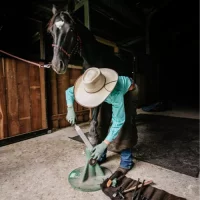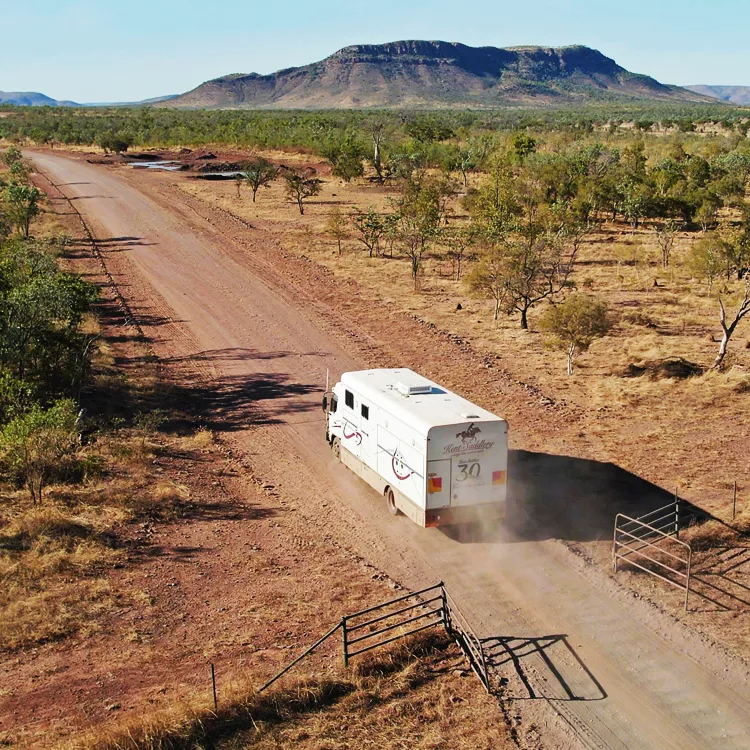Monkira Station, SW Qld
The pull of the channels
Monkira, far west Queensland, is a channel country station, and Anthony and Deb Desreaux and children Abby and Ty love it there. Anthony spent his childhood around Tibooburra and Deb was Broken Hill born and bred. They both grew up with horses.
When Anthony left school, he worked at Naryilco Station for five years and also did some contract mustering in the Tibooburra area. He was based in Broken Hill, where he met his wife.
NAPCO has a reputation for being the quiet achievers; and Anthony and Deb say “the company is good to work for. There’s a company plane and full time pilot which services all our stations in the area weekly, which is great. NAPCO is progressive, and encourages thinking outside the box; a water smart project is up and running at Monkira involving remote control monitoring of waters. It took a while to trust the system, but it’s very reliable, and we can check waters and flow rates from the office at any time.”
In 2000 the couple travelled to the Northern Territory, where Anthony took up a position as Head Stockman and later went on to manage Scott Creek Station, near Katherine. Two years later the pull of the channels and the position of manager landed them at Monkira.
They describe Monkira as, “diverse country, 70% is channels. When a big flood comes down, the water is 30 kilometres across in some places and the native sorghum grows 5 feet high. Monkira is a fattening station, and even in drought conditions the cattle do well; weight gains are phenomenal. When we first came to Monkira, the cattle were the best we’d ever seen; excellent, quiet cattle.”
Deb is particularly interested in Monkira’s history, carefully preserving memorabilia from 1939 when NAPCO first took over at Monkira, and Bob Gunther was manager for 30+ years. “Some of the descendants of the original owners of Monkira are still involved in the NAPCO management. Monkira boasts the largest coolibah tree in the world, and the Mackhara waterhole, the site of the original settlement, has never been dry.”
Anthony and Deb are passionate about and committed to the 26 horses on the station, and Anthony states, “ or me, they’re the only way to work cattle. Horse work teaches young fellas to be stockmen so they learn where to be, why to be and what to do when they get there. We also use motorbikes, but there are always two people on horses, no matter what.”
Anthony and Deb are passionate and committed to Natural horsemanship, using the Parelli method. They’re convinced it promotes safety and confidence as riders are taught to read the horse’s behavior and deal appropriately with the horse that shows up on the day.
“There’s a huge difference with horses educated this way. They want to be with you. They’ll load themselves onto the gooseneck and invite other horses you don’t need for the day. They catch you, no more chasing and blocking them up in the corner for half an hour trying to catch them with the bridle hidden behind your back.
At the time of our visit to Monkira, Anthony and Deb were preparing for a six week Parelli course in the US of A. They reported back with the following:
“We travelled to Pagosa Springs, Colorado. Beautiful! We stayed in a log cabin on the ranch owned by Pat and Linda Parelli. Anthony completed a six week Natural horsemanship course. He also had the privilege to ride and spend time with Pat Parelli. He rode one of Pat’s super mares in the cutting pen, a privilege on its own. It was the education vacation of a lifetime. They have totally different ways with cattle and only use horses for mustering, drafting and doctoring. We recommend anyone to go over and experience the beef and equine industries in the USA. Anthony also met and spent time with two other legendary American horsemen, Ray Hunt and Craig Cameron.”
Monkira’s homestead complex is in a central position on the property; close to the Bedourie Windorah Road. Often welcoming a few truckies, who need a shower, a coffee or a meal, Anthony and Deb also keep contact with many past employees, and travellers who return to spend time at the waterholes.
A retiring channels manager recently warned Anthony, “Careful you don’t stay here too long; you’ll be 65 before you know it, and still here!” We have a distinct impression that Anthony and Deb may consider that the possibility is not such a bad thing!
Kent Saddlery has been privileged to supply saddles for the station. We are committed to making saddles which are comfortable for horses, and allow them to move more freely. We agree with Anthony that “the future’s very much in front.” A properly made saddle is high priority for people who care for horses, and we’re pleased when Deb shares that she’s “seen riders with Kent saddles competing at campdrafts and rodeos whose horses are “Full in their body” (movement). The horse is alert, and bright, and you can see the difference. We tried some other Australian made saddles in the stock camp and they were good, but didn’t stand up like a Kent saddle.”
Regarding our visits, Deb says “We love your visits. You provide good stuff, good gear for the stations.” Anthony adds “Put it this way; without you guys there wouldn’t be much. Everybody’s saddle sheds would be pretty empty, and a lot of people would be riding in old flap saddles! I wouldn’t buy any other saddle but yours for the stock camp, they’re just the best tough saddle.”















